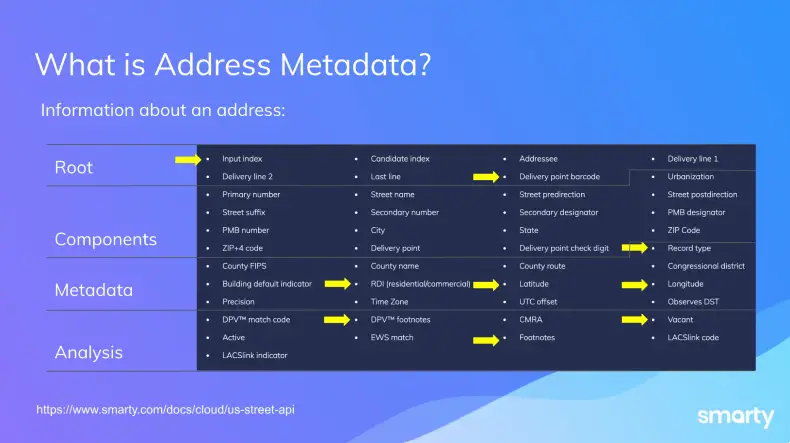
Did you know that every address has loads of hidden data buried in its metadata? In this webinar, we briefly considered the value of breaking an address into its component parts. Then we looked at the different metadata available and provided definitions for each one. And finally, we went over use cases and ideas on how to leverage metadata for improved operations, business intelligence, and financial performance.
There’s gold in your address metadata!
Every address contains basic components that are standardized by country. In the US, the components are:
▢ Primary Number▢ Pre Direction
▢ Street Name
▢ Street Suffix
▢ Post Direction
▢ Secondary Designator
▢ Secondary Number
▢ City
▢ State
▢ ZIP Code
While each of these is valuable, there’s knowledge and data available that’s associated with every address. It’s THAT data—categorized as Root, Components, Metadata, and Analysis—that can bring a new life and a wealth of information to your address database.
What is Address Metadata?
Address metadata is simply information about an address. Smarty provides up to 45 points of metadata for every address.
Because there is a lot of metadata and the webinar promised to be a short one, we only went over 9 of the data points that are offered, as indicated with yellow arrows in the image below:

Break Down of the Metadata
- Root
- Input ID - Your identifier to reference the input & output address
- Input Index - The order in which an address was submitted with others
- Delivery Point Barcode - 12-digit barcode; consists of 5-digit ZIP Code, 4-digit add-on code, 2-digit delivery point, and 1-digit check digit
- Components - Details listed above
- Metadata
- Record Types - Indicating what type of building is at the address, ex: highrise, rural, street, etc.
- Residential Delivery Indicator - Whether the building is zoned as residential or commercial
- Geocodes - Latitude and longitude for each address
- Analysis
- Vacancy Indication - Whether the USPS registered the address as vacant or not.
- Footnotes - The notes on what was done to obtain a match
- DPV Footnotes - The quality of match for each address
Try it yourself
If you want to start getting this hidden treasure, along with crazy accurate address validation and rooftop geocoding, you can try it out yourself for FREE by visiting our Single Address Verification Tool.
Do you want to validate and get this data on more than one address at a time? Try our bulk address lookup tool, also for free, by signing up for a free account.
You can also view the full webinar recording here:

 Andrew Townsend
Andrew Townsend